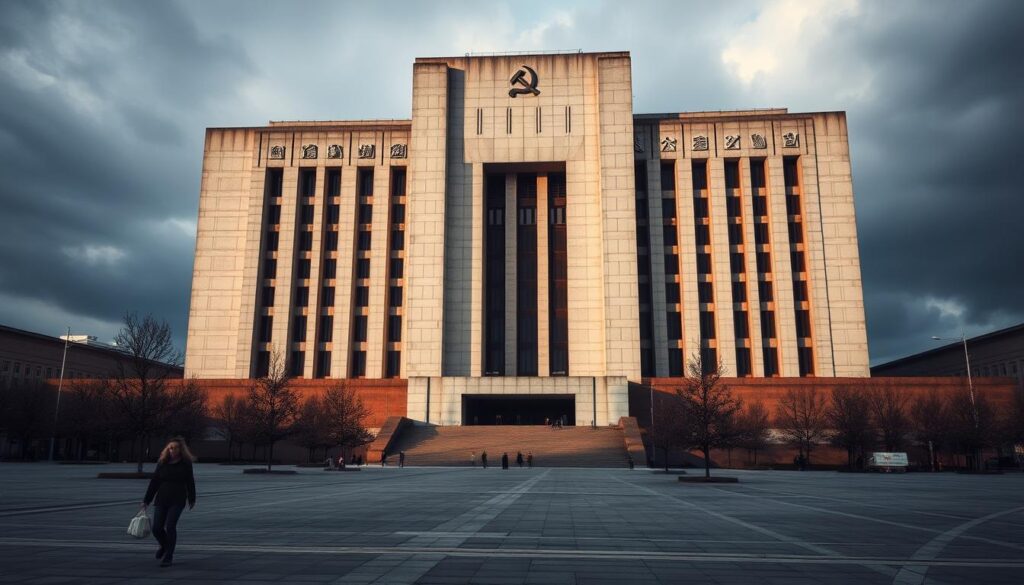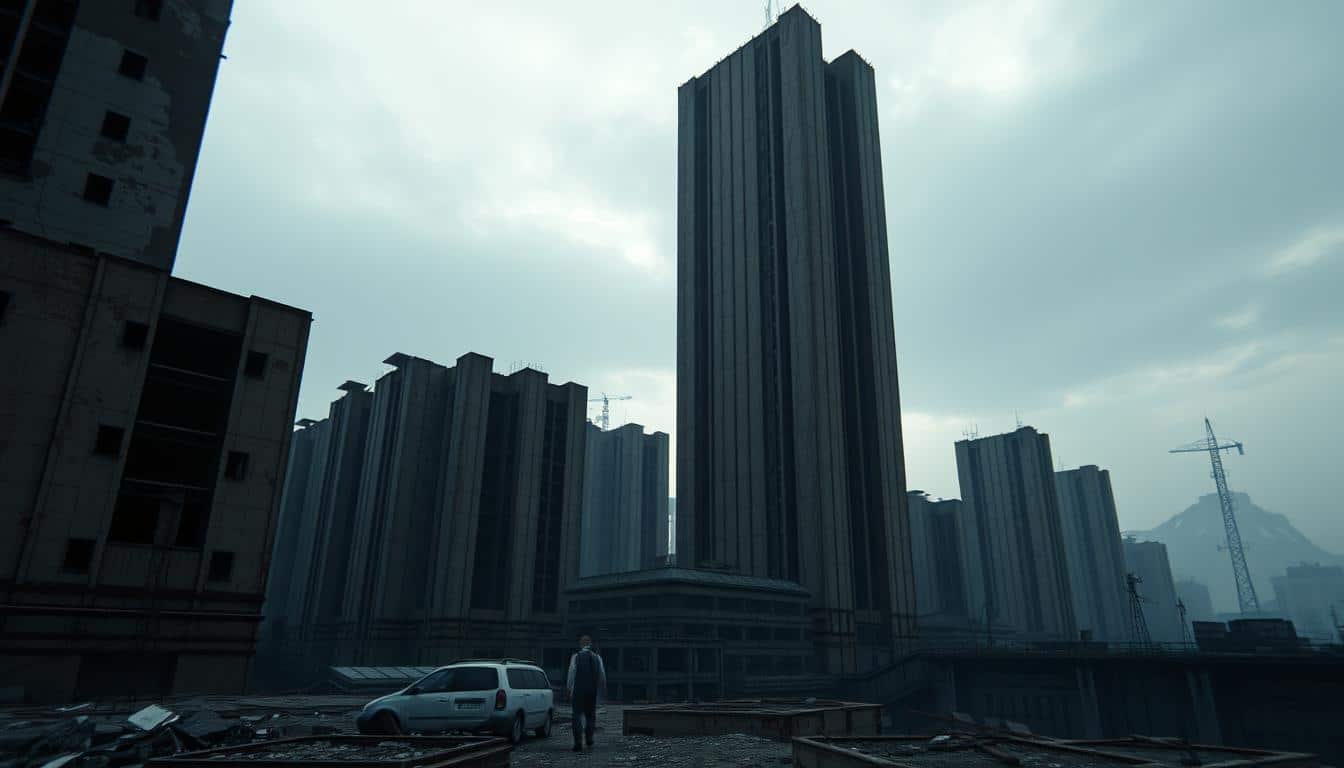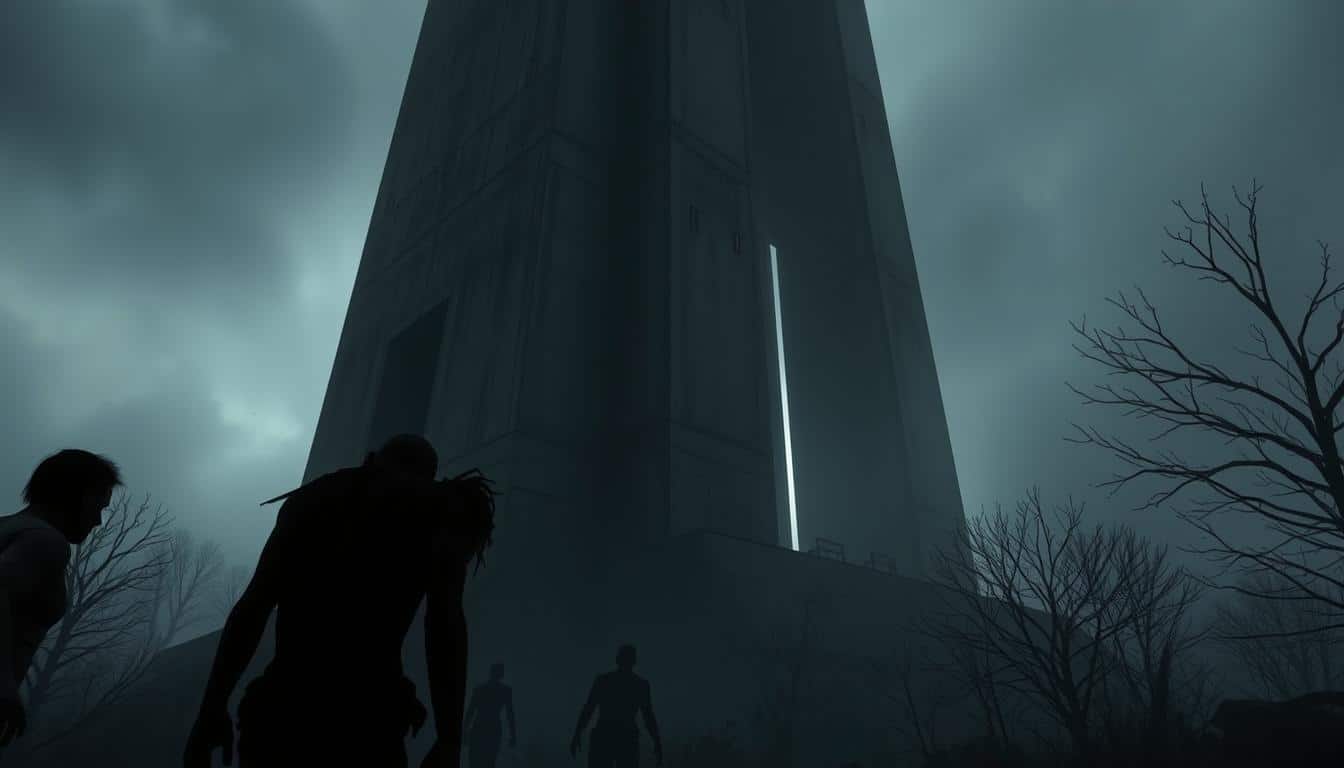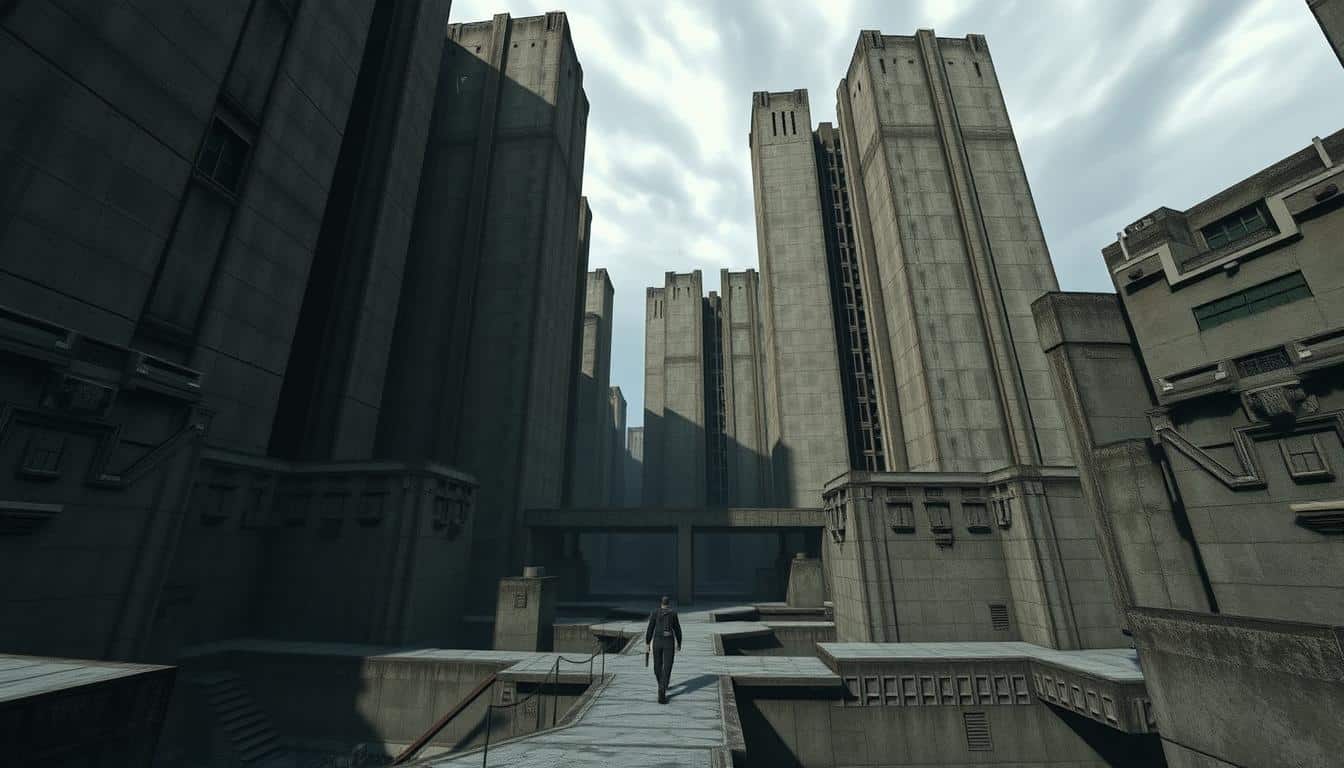In recent years, Soviet brutalism has greatly influenced game design. Developers and players find it fascinating. This style is known for big concrete buildings and simple looks. It gives virtual worlds a unique setting.
We’ll look into how Soviet brutalism started and what makes it special. You’ll see its impact in famous video games. We aim to show how this style deeply affects gaming experiences.
The Origins of Soviet Brutalism
Soviet brutalism started in the late 1940s. It was shaped by the socio-political climate of that era. Right after World War II, the Soviet Union needed to rebuild cities quickly. This need led to a style focusing on usefulness, affordable materials, and clear social goals.
Architects wanted their buildings to look serious and powerful. They used raw materials and simple shapes, which became key features of Soviet architecture. These design choices showed the country’s wish for modernity and advancement. The brutalism movement helped address housing and public space needs, linking closely to the Soviet Union’s cultural identity.
Thus, Soviet brutalism is more than a style of building. It mirrors the shared dreams of a society looking to rebuild and move forward after hardships.

The Characteristics of Soviet Brutalist Architecture
Soviet brutalism is known for its unique architecture that highlights function and strength. The main material is raw concrete, used a lot, making buildings strong and impactful. It favors simple shapes, removing unneeded details to focus on the building’s purpose and structure.
This style is also marked by its modular design, featuring repetitive patterns and shapes. These elements bring a sense of unity and harmony. The heavy use of mass gives these buildings a commanding look. This straightforward design style can stir deep feelings in those who see it.
The mix of these features tells a story of endurance and usefulness. It reflects the powerful societal factors that influenced this style when it began. The bold beauty of these buildings shows us the hopes and dreams of that era. This makes Soviet brutalism an interesting topic in both architecture and its cultural impact.
Soviet brutalism architectural style in gaming visuals
Soviet brutalism gives game environments a unique twist. Its practical design and raw look offer a captivating style that boosts the gaming experience.
The Role of Textures and Materials
Using different textures and materials is key to making game worlds feel real. Game creators often use rough concrete and strong industrial items. These details make the visuals more engaging and full of emotion.
They encourage gamers to check out areas that remind them of real cities. This adds to the story’s richness and pulls players into the action.
Symbolism of Power and Control
The architecture of Soviet brutalism does more than just look cool. It also gets players thinking about power and control. These big buildings represent authority and influence how players move through the game.
The way these spaces are designed fits perfectly with the game’s story. They highlight the battle between freedom and control. This setting makes the game’s challenges even more intriguing.
Iconic Examples of Soviet Brutalism in Games
In gaming, some titles really stand out because they show off Soviet brutalism. They mix architecture with gameplay and story well. Games like Control, with its big Oldest House, and NaissanceE, invite players to explore and think deep while playing.
Analyzing “Control” and the Oldest House
Control, by Remedy Entertainment, makes the Oldest House a key part of its story. This huge building is more than just a setting. It shows off big themes like government control and unknown forces. The way it’s built changes how players feel, making the game feel tight but also amazing.
As players move around, the building changes. This makes it feel like the place is telling its own story. It turns the brutalist style into a way to dive into big life questions.
“NaissanceE” and Its Unique Interpretation
NaissanceE takes a different route with brutalism. It puts you in a world of simple shapes and big, empty spaces. This style makes players feel alone and think about big things, like how tiny we feel in huge buildings. The game blends exploring with strong feelings, making it really stick with you.
The Emotional Impact of Brutalist Design in Gaming
Brutalist design in video games stirs deep emotions, making the gaming experience richer. This style brings feelings of wonder and fear, pulling players into huge, bare settings. These settings test how they see the world. As they explore these tough spaces, players feel a stronger bond with the game.
Brutalist buildings create a mood full of tension. This mood makes players dive deeper into the story. The heavy look and different styles make players think more about feeling small against these giant settings.
Level Design Influences from Soviet Brutalism
Games inspired by Soviet brutalism offer new ways to think about space and size. The big and bold structures impact how games feel and play. Players might feel amazed or uneasy in these huge, simple spaces.
This setting encourages exploring and overcoming challenges posed by the environment.
Utilizing Space and Scale in Gameplay
Using Soviet brutalism in games lets creators play with size in clever ways. Massive buildings can make exploring fun or leave you feeling lost. The environment often has:
- Large, repetitive geometric forms that enhance immersion
- Verticality that tests players’ navigation skills
- Open spaces that encourage strategic movement while presenting psychological barriers
This design approach not only makes games more engaging but also deeply captivating. By smartly using space, developers pull players into these tough, mysterious worlds.
The Intersection of Liminal Spaces and Brutalism
Liminal spaces are the in-between, blending well with brutalism’s stark looks. These areas make us wonder about our place in the game. Brutalist architecture gives places a both familiar and strange vibe, mixing up usual designs.
In games, liminal spaces and brutalism make us want to explore more. They bring out feelings of unease and curiosity, making us more connected emotionally. Moving through these places, players feel both safe and scared, adding depth to their game journey.
Brutalism, known for its raw materials and big shapes, makes stories in liminal spaces even more engaging. This mix makes players both interact with their surroundings and think differently about space. The gameplay becomes richer, with uncertainty playing a big role in the adventure.
Future Trends in Game Design Inspired by Soviet Brutalism
Game design is evolving, and Soviet brutalism is becoming more influential. This style offers a unique look for game developers. They can make games more immersive and emotionally powerful by using brutalism.
With new tech, games are becoming more innovative. They might blend brutalist design with virtual reality. This mix makes games more real and engaging. Players will find new ways to explore and interact in these spaces.
Games are mixing visuals with interactive play more than ever. They will use the simple yet strong style of brutalism. This approach enhances how players shape the game while keeping a unique visual style. The design’s growth shows its impact on gameplay and how it makes players feel.
Conclusion
The lasting impact of Soviet brutalism on game design shows how architecture influences stories in games. The unique features of brutalism have changed how games look and feel. This lets players connect more with the game’s themes.
Brutalism offers a deep way to see how architecture and gaming mix. Its simple, yet big designs bring out strong feelings. These feelings help game makers create stories that make us see space and control differently.
Games will keep being inspired by the raw feelings from brutalist architecture. As games grow, Soviet brutalism’s ideas will shape how we see and play in these virtual spaces. This will make gaming even more exciting.



